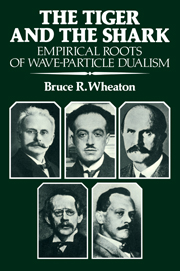Book contents
- Frontmatter
- Contents
- Foreword by Thomas S. Kuhn
- Preface
- Notes on sources
- 1 Introduction
- Part I The introduction of temporal discontinuity, 1896–1905
- Part II Ionization and the recognition of paradox, 1906–1910
- 4 Secondary rays: British attempts to retain mechanism
- 5 The appeal in Germany to the quantum theory
- Part III Seeking an electrodynamic solution, 1907–1912
- Part IV Interference of x-rays and the corroboration of paradox, 1912–1922
- Part V The conceptual origins of wave–particle dualism, 1921–1925
- Epilogue: The tiger and the shark
- Bibliography
- Index
4 - Secondary rays: British attempts to retain mechanism
Published online by Cambridge University Press: 04 August 2010
- Frontmatter
- Contents
- Foreword by Thomas S. Kuhn
- Preface
- Notes on sources
- 1 Introduction
- Part I The introduction of temporal discontinuity, 1896–1905
- Part II Ionization and the recognition of paradox, 1906–1910
- 4 Secondary rays: British attempts to retain mechanism
- 5 The appeal in Germany to the quantum theory
- Part III Seeking an electrodynamic solution, 1907–1912
- Part IV Interference of x-rays and the corroboration of paradox, 1912–1922
- Part V The conceptual origins of wave–particle dualism, 1921–1925
- Epilogue: The tiger and the shark
- Bibliography
- Index
Summary
There is … a reasonable argument that the γ and x rays are also material.
When x-rays or γ-rays strike atoms, electrons and secondary x-rays are emitted. Experiments to sort out the differing properties of the two secondary components produced new and perplexing observations in the first decade of this century. The most perplexing problems concerned the effect of the rays in producing secondary electrons. First, x-rays and γ-rays ionize only a small fraction of the total number of gas molecules through which they pass. Spherically expanding pulses should affect all molecules equally; manifestly, they do not. Second, the velocity that x-rays impart to electrons is many orders of magnitude higher than one would expect to come from a spreading wave. The energy in the new radiations seemed to be bound up in spatially localized packages, available to an electron in toto.
British physicists responded to these paradoxes with attempts to revise, rather than replace, classical electromechanics. J. J. Thomson suggested that old ideas about the microscopic structure of the aether might have to be reformulated. William Henry Bragg concluded that x-rays and γ-rays are not impulses at all but rather neutral material particles. Bragg and Thomson tried at first to find explanations using models based on human experience with machines. Each sought a resolution within the context of classical mechanics; each ultimately failed.
- Type
- Chapter
- Information
- The Tiger and the SharkEmpirical Roots of Wave-Particle Dualism, pp. 71 - 103Publisher: Cambridge University PressPrint publication year: 1983



